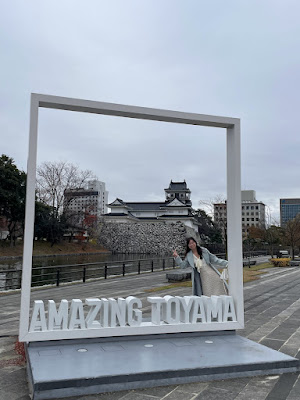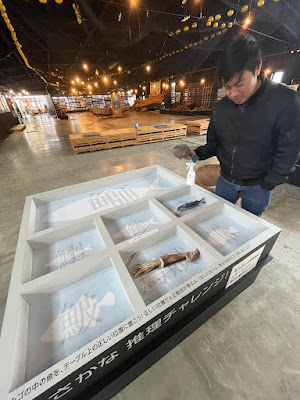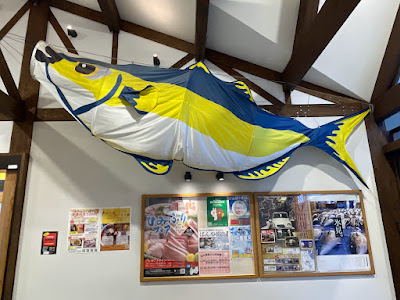We spent the last day of our short 3-day trip in Toyama prefecture. Toyama is known for its mountains and particularly the Tateyama-Kurobe Alpine Route, but unfortunately we were visiting during the wrong time of year for it and didn't have a ton of time to get to that area. Instead, I shifted our focus to the other feature of Toyama - seafood!
But first, we ventured into Toyama city. We checked out of our hotel in Kanazawa in the morning, and drove about an hour to Toyama city, finding parking in one of the paid lots near Toyama Glass Art Museum. The building itself is noteworthy, but somehow I never got far away enough at the right angle to get a photo of it lol.
We entered shortly after 09:30 and bought tickets for just the regular exhibits on the 4th and 6th floor (not the special exhibition which was on 2F and 3F while we visited). The rest of the building seems to be quite open with parts of it looking like a library and also featuring a cafe. It's quite modern and interesting looking.
For the glass art itself, unfortunately photography was prohibited inside the 4th floor collection, but this is a photo from the outside. The theme for these pieces was "layers" and it was interesting to see how different artists used glass in different techniques to achieve such versatile pieces. The placards by each piece had English alongside the Japanese.
The 6th floor is where the Chihuly permanent exhibition is which includes pieces that were specifically commissioned for Toyama Glass Art Museum. While photos are allowed in this area, the rules specifically requested that they not be posted on social media, so respecting that, here's just a photo from the outside that anyone, even without an admission ticket would be able to see with the chandelier pieces in the distance.
This collection is definitely small compared to what's available in Seattle, but it does have a cozier atmosphere. There are 3 (blue, red and yellow) hanging pieces at the entrance hall after some informational posters about Chihuly and his work. Further in, there is a large piece featuring blue stalagmite in wood. Following that is a low glass art ceiling in an interior hallway with his iconic nautical shapes and cherubs, oddly enough. The last two larger pieces are a Toyama float boat (wooden boat with many difficult glass orbs) and a version of Mille Fiori which is another iconic style you'd instantly recognize as Chihuly.
As mentioned, this prefecture is known for seafood, and this particular area is especially famous for the seasonal large kan-buri or winter yellowtail. Because of the large size (over 10kg), the taste is supposed to be exceptional and Himihama focuses on this larger size during the winter when the fish are available.
We arrived a little early for our 13:00 reservation but the staff greeted us warmly and once they figured out we didn't speak much Japanese, brought out the little course menu in English and also simplified the explanations and used a translation app for more complicated things, so we didn't have to be confused about anything. The menu is limited to course-style, even for lunch, so we didn't need to choose anything! The starters (salted squid, vinegared seaweed, tofu, pickles and bai shellfish) were already waiting on the table for us. The first course is kan-buri sashimi!
Next up, shioyaki (salt grilled) buri which was very generously sized and then buri daikon (such a big daikon chunk for me lol) which had a very nice flavor as well.
And if that wasn't enough, the main dish is buri hotpot/shabu shabu. It comes with a konbu broth, vegetables and surprisingly thick cut raw buri. Start with the vegetables and then cook the buri to your desired doneness. Recommended was about 7 seconds, but you could try 3 seconds...or longer, or eat it raw if that was your preference!
The lunch was finished with cold himi udon (not pictured because I completely forgot) and you can pick the serving size. We were quite full by this point, so we opted for the small portion, but they will even bring more if you ask for it after. The recommended way to eat it was cold, with the ponzu dipping sauce. Alternately, you try putting it in the shabu broth and then flavoring with a little shoyu to eat it hot. This was refreshing and a great way to end the meal.
Since we were in Himi, we also stopped by the giant ginko tree in Jonichi-ji (part of Asahiyama Jonichi Temple). It's certainly off season for this. No one else was around and the leaves were all gone! But it truly is massive, especially when you're right up next to it in person. It must be so much more imposing when it's full of color.
Last two stops before we headed out were the Himi City Fisheries Cultural Exchange Center and the Himi roadside station. The exchange center looks quite grand and new. On the day we visited, there only two or 3 other couples inside, so we had a lot of the place to ourselves.
It's quite open inside and comfortable with lots of different displays, including some fun activities like this interactive one which is to match the stuffed fish with the name. It even beeped or chimed to indicate if you got it wrong or right!
There were also displays and different explanations about the special technique used to catch the fish which stresses them out less than other methods (resulting in tastier fish!).
In the grocery store at the end, I ended up buying this chocolate bar that was in a fridge box and it was legitmately so good lol. (Seemingly nothing to do with the local area, but I really enjoyed it.)
The lunch was finished with cold himi udon (not pictured because I completely forgot) and you can pick the serving size. We were quite full by this point, so we opted for the small portion, but they will even bring more if you ask for it after. The recommended way to eat it was cold, with the ponzu dipping sauce. Alternately, you try putting it in the shabu broth and then flavoring with a little shoyu to eat it hot. This was refreshing and a great way to end the meal.
The staff at Himihama were very attentive and welcoming to us despite not having a lot of Japanese language speaking skills. I highly recommend trying the kan-buri course here if you get a chance to visit in during the right season. Definitely make a reservation, especially if you have to travel specifically to get there and remember that payment is in cash only.
Last two stops before we headed out were the Himi City Fisheries Cultural Exchange Center and the Himi roadside station. The exchange center looks quite grand and new. On the day we visited, there only two or 3 other couples inside, so we had a lot of the place to ourselves.
The roadside station was split into several smaller buildings and mostly contained small individual vendors, many of which were selling fresh fish or other seafood available to be shipped.
While we didn't get to fully exhaust each prefecture we visited, I am happy with what we were able to accomplish with 3 days with first and last including transit travel as well. We got to try regional specialties (sauce katsu don, habutae mochi, nanakoshi, kan-buri) and some local chains as well (Hachiban Ramen, Champion Curry). It's great to finally check off the Giant Squid statue from my Japan bucket list!

✤ Hokuriku 3-day trip

















































No comments:
Post a Comment